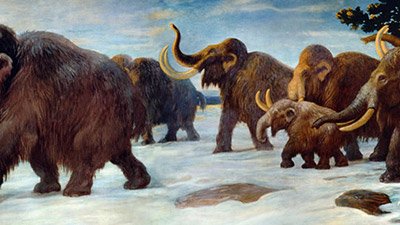What Mean These Mastodons?
Varieties of fossilized mastodons, mammoths, and other elephants are widely distributed across North America and around the world.
It made for some news when a researcher whimsically suggested changing the name of a Colorado mountain town from Snowmass to “Snowmastodon” in honor of the recent discovery of a treasure of fossil elephants, especially mastodons, other fossil mammals, and plant remains preserved in a peat-rich deposit. As we saw on a visit with our grandchildren, the Denver Museum of Natural History was celebrating the occasion with the sale of several books at different levels, cuddly stuffed mastodon toys, special mastodon dig kits for young (future) paleontologists, and of course, the inevitable mastodon-touting T-shirts.
The native Floridians (“Indians”) were hunting live elephants for their hides and meat.
Actually, varieties of fossilized mastodons, mammoths, and other elephants are widely distributed across North America and around the world. There’s a major deposit in northern Kentucky, not far from AiG’s Creation Museum, at what is now called Big Bone Lick State Park. President Thomas Jefferson was aware of these fossils, and advised famed explorers Lewis and Clark to keep their eyes open for elephant herds as they explored the land obtained through the Louisiana Purchase. The duo didn’t miss them by much, it seems. The state museum here in Florida (where we live) tells us the native Floridians (“Indians”) were hunting live elephants for their hides and meat as recently as 4,000 years ago (i.e., about 500 years after the Flood of Noah’s day) if their reckoning is correct. Indeed, paleontologists blame the final extinction of many large mammals in Florida on over-hunting by local peoples.
The average elephant, mastodon or mammoth, is actually much larger than the average dinosaur, and many other large mammals also lived recently in Florida. The giant ground sloth (Eremotherium) was larger than T. rex, a giant member of the armadillo group (the glyptodont) was as big as an SUV, and of course there is the famous saber-toothed cat (Smilodon, state fossil of both Florida and California), and several other giants, including a giant bison. The skull of a giant bison in the state museum actually has an arrowhead embedded in the bone between the eyes (but the wound appeared to have been healing, so the bones of a certain hapless human hunter might one day be found!)
Sites rich in vertebrate bone are rare and usually restricted (as the Colorado “Snowmastodon” site is now). One of the best places on earth for amateurs to hunt fossils of large vertebrates is the Peace River, which runs close behind our home and our modest “Creation Adventures Museum” in Arcadia, Florida. With just a screen and shovel to sift through the sands in the wide and shallow Peace River, a homeschool family, group of students, etc. can find fossil fragments of bones and teeth from the giants mentioned above, plus camels, llamas, horses, deer, tapirs, bears, alligators, numerous turtles and tortoises, and an occasional rhinoceros. Found along with the land vertebrates are many marine vertebrates: whales, dolphins, walruses, sea cows (dugongs and manatees), pufferfish, sturgeons, rays, gars, and abundant shark teeth of numerous kinds, including some of gigantic size.
Land and sea creatures preserved in shell-rich deposits throughout the state have earned Florida fossil deposits the descriptive designation “fossil hash,” a distribution quite unlike the stacked bands of ecologically consistent fossil strata visible at Grand Canyon and (less spectacularly) in most other sedimentary units around the world. Could Florida’s “fossil hash” be a super-storm deposit following and generated by events related to Noah’s Flood?
Researchers at the “Snowmastodon” site in Colorado talked about indicators of climate difference at the site (a “climate change” that could not have been caused by man’s so-called “carbon footprint”). Creationist researchers have suggested that changes initiated by the Genesis Flood would produce both ice buildup toward polar latitudes and super-storms (hypercanes) toward tropical latitudes. So, fossils from Colorado and Florida may contribute to the vital effort to separate fact from the considerable fiction surrounding global climate change.
We tell participants in our museum programs that fossils are “missionaries.” Their design features proclaim God’s wondrous creation. Their death, disease, and decline point to the corruption of creation following sin, and their fossilization in globe-encircling, water-laid sediments to the catastrophe of Noah’s Flood. But—praise God—life’s deliverance from judgment encourages faith in the redeeming work of Jesus Christ!
To learn more about how to relate news of God’s world to truths in God’s Word, join us in Florida at the Creation Adventures Museum.
Recommended Resources

Answers in Genesis is an apologetics ministry, dedicated to helping Christians defend their faith and proclaim the good news of Jesus Christ.
- Customer Service 800.778.3390
- © 2025 Answers in Genesis






